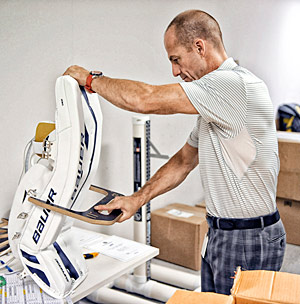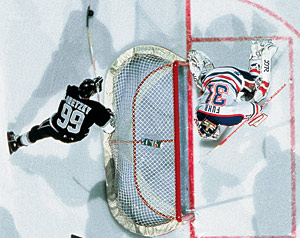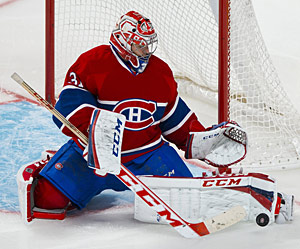NHL working to halt scoring drought, but more must be done

This story originally appeared in the Sept. 30, 2013 issue of SPORTS ILLUSTRATED. To subscribe, click here.
On a Sunday in early September, Kay Whitmore helped his family in Sudbury, Ont., jar 13 bushels of tomatoes, drove four hours to his house near Toronto, ate dinner, changed clothes and then continued to the NHL's downtown offices, where he started work shortly before 9 p.m. Whitmore has an office on the 10th floor but conducts much of his business one floor up, in a storeroom near the elevators. Some 50 boxes, many empty, others filled with goalie pads or chest protectors, clutter the room. With the tools of his singular -profession—box cutter, calipers, tape measure, paper clips, Sharpies, loose-leaf binder and a stand constructed on four-inch tubing that looks like something a pediatrician might use to check a toddler's height—Whitmore measures every piece of equipment for every professional goaltender in North America. His title is senior manager of Hockey Operations. Informally he is the goalie cop, and he walks his beat alone.
When Whitmore determines that a leg pad conforms with Rule 11 governing goalie equipment (and he has had to play UPS Ping-Pong with manufacturers until gear has met specifications), he writes kw nhl lds 45 and the date at the bottom of the pad with a black, gold or silver Sharpie and readies the equipment for shipping. The meanings of kw and nhl are self-evident. lds stands for limiting distance size, which is the maximum height of each goalie's leg pads and is determined by some simple math. In August the league and the players' association agreed that leg pads could extend only up to 45% of the way from the center of a goalie's knee to his pelvis, down from 55%. Now the formula for determining LDS, devised by Whitmore and his friend Walter Karabin, an architect and engineer, is:
FK (floor-to-knee length) + 0.45 x KP (knee-to-pelvis length) + 4 (inches from the ice to the top of the skate tongue, a constant for all goalies).
For you history majors out there, think of it like this. To you, Corey Crawford is the Blackhawks' 6' 2" Stanley Cup-winning goalie, right? To Whitmore, Crawford is a 22-1⁄2-inch floor-to-knee, 21-inch knee-to-pelvis guy whose measurements now oblige him to wear 35.95-inch pads, which the goalie found incredibly short when he first strapped them on. (His old pads were 38.05 inches.) You know the Devils' 6' 2" Martin Brodeur as the alltime wins and shutouts leader, but in Whitmore's world he is a 21-1⁄2-inch floor-to-knee, 21-inch knee-to--pelvis guy whose pads must be no taller than 34.95 inches. Because the Canadiens' 6' 3" Carey Price has a long torso and short legs, his pads are 34.79 inches.
The x-factors in the equation are how, and how quickly, goalies will adjust.

In an effort to boost scoring this season, most goalies will lose roughly two inches off the height of their pads. (The range is zero to 2-1⁄2 inches.) Even a goalie who drops into a perfect butterfly to hermetically seal his five hole is theoretically leaving an extra four inches of shooting space at the bottom of the six-foot-wide net. But this is just the start of a chain reaction. Maybe some goalies will compensate by dropping into the butterfly more quickly, which will leave more time for shooters to go top shelf. Or maybe some goalies will once again need their sticks to help close the five hole, meaning they won't be able to tuck their elbows into their sides, which in recent years has closed the seven hole, the space between the hip and the blocker. Or if a goalie is worried about covering post-and-in shots, he might inch farther out from the net, which makes him vulnerable to late cross-ice passes. "The five hole is now a 5.2 hole," Maple Leafs goalie James Reimer told reporters.
Whitmore plans to be on the road at least two weeks every month this season to make random postgame checks of goalies' equipment. "The league was worried about the width of pads," he says (they were trimmed from 12 to 11 inches in 2005), "[but] because pretty much all goalies butterfly, length was the real issue."
Good times return
The NHL is practically all rainbows and unicorns at the start of 2013--14. The third lockout in Gary Bettman's two decades as commissioner produced an agreement last January that could bring as much as a decade of labor peace. The truncated season ended with a scintillating Stanley Cup finals between the Blackhawks and the Bruins that pulled in some of the best TV numbers in the league's history. The ongoing embarrassment of the Coyotes was resolved (at least for five years) when the NHL sold its ward to IceArizona Acquisition Co. for $170 million on Aug. 5. With New Jersey in a precarious state during the summer, drowning in a reported $200 million of debt, Bettman found new ownership for the Devils in a New York minute. (76ers owners Josh Harris led a group that paid $320 million.) The salary cap is down to $64.3 million from the $70.2 million it would have been for a full 2012--13, but a glut of six outdoor games, including a Jan. 1 match at Michigan Stadium in Ann Arbor between the Red Wings and Toronto should goose revenues for a league that now routinely produces hype and hypothermia.
Realignment should enhance playoff rivalries, echoes of the wonderfully brutish springs of the old Norris and Adams divisions. The most intriguing individual rivalry, Sidney Crosby versus Alexander Ovechkin, has been reignited by Ovechkin's strong close to the 2013 season, in which he edged the Penguins' captain for the Hart Trophy, won his third goal-scoring title (32 goals) and performed so brilliantly that members of the Professional Hockey Writers' Association voted the Capitals' offensive wizard an All-Star twice—as the first-team right wing and as the second-team left wing.
There are some red flags: 215 man-games were lost to reported concussions or concussionlike symptoms in the shortened season, and Ilya Kovalchuk's "retirement" in New Jersey and subsequent move to St. Petersburg of the KHL deprived the league of one of its most dynamic forwards. But all in all, 2013-14 looks like blue skies.
The nagging pebble in the NHL's skate remains scoring. As former Sabres president Larry Quinn told SI last winter, "The U.S. is looking for offen-sive hockey. So is TV. People became hockey fans because of Bobby Orr, Wayne Gretzky, Mario Lemieux, Gilbert Perreault." Despite rules changes and reconfigurations after the 2004-05 lockout—new officiating standards for obstruction fouls, the installation of the trapezoid behind the nets (which limited how much goalies were able to handle the puck) and the removal of the red line for purposes of two-line passes—offense has been sclerotic. Since 2000-01 there have been 22 50-goal seasons. In 1992-93 and '93-94 combined there were 23. While the flow of the game has improved since the '04-05 crackdown on hooking and holding, hockey's red-light district (the red goal light flashing, the siren, the roar, the celebration) is not the fun place it was in the not-so-distant past.
"The NHL has been getting fans to the edge of their seats," says former goalie Glenn Healy, now an analyst for Hockey Night in Canada on the CBC. "It wouldn't hurt if they could get fans out of their seats a couple of more times a game."

At their meetings in Boston during the 2013 Stanley Cup Final, general managers stressed to players' association representatives that the size of goalie pads had to be reduced immediately. "They said we would be ruining the game if we didn't get this done," says Mathieu Schneider, the NHLPA's special assistant to the executive director. Many of Schneider's constituents agreed, although without the pearl-clutching melodrama of the GM's. The NHLPA posted two polls on its internal website in June, one for skaters and another for goalies. The question: Should goalie equipment be shrunk? The skaters were in favor. And to Schneider's surprise, so were a "sizable minority" of goalies. "I thought it would be only two or three guys," Schneider says. "It wasn't that." Voilà! The 45% solution followed soon after, leaving manufacturers scrambling and some goalies grumpy. (Phoenix's Mike Smith on the change: "Horrible.")
There have been other nips and tucks in the league's 2013-14 face-lift to help boost scoring. The NHL has reduced the depth of the goal from 44 to 40 inches, which will give nifty forwards such as Crosby and Chicago's Patrick Kane more room to maneuver when they set up in Wayne Gretzky's old office. The league also trimmed the goal frame, which includes the side skirting, from 96 to 88 inches, which should allow lanky players such as the Kings' Anze Kopitar a better angle for wraparounds and open passing lanes to forwards who have stationed themselves in prime scoring positions. The stretch pass never did touch off a scoring explosion, but maybe hockey will prove to be a game of inches.
"If we can only get another goal and a half..." says one senior league official. Teams produced an average of 5.31 goals per game in 2013, the fewest since '03-04. If you are unfamiliar with the concept of .31 of a goal per game, you were not watching the Panthers last season.
In 1968 Cardinals ace Bob Gibson had a 1.12 ERA and 13 shutouts. Baseball's collective ERA was 2.98. Carl Yastrzemski's .301 batting average led the American League. Responding to the imbalance between pitching and hitting, Major League Baseball lowered the mound to 10 inches from 15. A year later ERA rose by .63 and Rod Carew won the AL batting title with a .332 average.
The NHL has no quick fix for scoring like MLB's monkeying with the mound. Maybe no slow fix, either. From an average of 7.94 goals per game in 1985-86, the league meandered into the wasteland of the Dead Puck era, which officially began in '97-98 with a goals-per-game average of 5.28, down by more than half a goal from the previous year. Only once since '95-96 has the average topped six goals: the 6.05 goals per game in '05-06, the first season of the new officiating standards, which was driven by a post-expansion record of 11.67 power plays per game. Despite periodic musings about expanding the four-by-six-foot nets, NHL executives concede there is no genuine appetite for it. Do not even suggest the nuclear option, four-on-four for 60 minutes.
While Crosby favors the paring down of goalie gear, he says that if the NHL "wanted to increase scoring, [it should start] with the game. When you look at penalties, the more they crack down on obstruction and hooking, it opens things up for skill." Crosby began to develop his once-in-a-generation talent as a boy in Nova Scotia by playing Timbits, a youth-hockey program supported by Tim Hortons, a restaurant chain specializing in coffee and doughnuts. With the popularity of the neutral-zone trap on the wane across the NHL, Crosby actually might again be playing Timbits. An elite version of it, anyway.
Timbits Hockey. The phrase is Paul MacLean's. MacLean is the Jack Adams Award-winning coach of the Senators, who scored more than 30 goals eight times in a career that stretched from 1981 to '91—the dying days of the Stand-Up Age, when a goalie would put weight on his left foot to move his right and MacLean would score by shooting at the weight-bearing foot. Alternating three-on-twos ruled, the study of video was a novelty and players scanned rosters before out-of-conference- games to figure out who was on the opposing team. In MacLean's view, goalie equipment has not choked scoring as much as video, goalie coaching and systems have.
"I compare the game now to when my son first played Timbits," MacLean says in his office at Ottawa's Canadian Tire Centre. "Puck on the ice, all 10 kids chasing it, trying to whack at it. If you watch an NHL game now, it's basically high-speed, high-skilled Timbits. Stop the videotape. You'll often see all 10 [skaters] in the picture. With the [neutral-zone] trap, it was one guy. Now it's pressure. Pressure on the puck. Almost everybody plays like that, because it works. There simply isn't the time or space available for players to score like we used to."
MacLean moves the tutorial to an anteroom with a giant screen and theater seating, across the hall from the Senators' dressing room. Forty years ago Scotty Bowman won a Stanley Cup in Montreal without an assistant coach. MacLean has four, including a goaltending coach, Rick Wamsley. Video coach Tim Pattyson cues up a series of clips from 2013. When he freezes a frame that reveals a thicket of players in the vicinity of the puck, MacLean says, "Timbits."
Perhaps the most revealing clip is of a promising Canadiens two-on-one against Ottawa defenseman Andre Benoit. Montreal winger Colby Armstrong is lugging the puck down the right flank as Erik Cole steams down the left. Instead of Benoit drifting toward Armstrong, as coaches once taught, the blueliner drifts toward Cole and allows backchecking defenseman Erik Karlsson—"tracking," in Senators parlance—to chase down Armstrong. The positions of both Karlsson's stick and his body remove the option of a cross-ice pass to Cole or, more dangerous, a drop pass to the Canadiens' late man, center David Desharnais. The two-on-one turns into a harmless chance from a hurried Armstrong at the right face-off circle. Goalie Craig Anderson, and almost all goalies in a league in which the average save percentage is .909, floss with shots from the dot.
"During the [2004-05] lockout they brought some of us [players] to a GM's meeting," says Hall of Fame winger Brendan Shanahan, now the NHL's senior VP of player safety. "GM's were talking about creating more two-on-ones, outnumbered rushes, more open spaces. Then [Hall of Fame defenseman] Scott Niedermayer said that with all the video and coaching, you can't teach us a smarter way of playing hockey and not expect us to do it. He said, 'You're not going to make players at this level stupid.' That's always stayed with me."
Scoring is down not only because the goalies got bigger, but so did hockey's IQ.
Let's get small

Goalie equipment has room to shrink. The blockers are too thick, the trappers too generous, and the ample pants can make goalies—who are bigger and more athletic than ever—look like rodeo clowns in barrels. Brian Hayward, who shared three Jennings trophies (for fewest goals allowed) with Patrick Roy in Montreal in the late 1980s, has proposed that goalies be measured by sitting in a chair with their legs bent at 90 degrees- and then be sized for pads that extend only three inches above their kneecaps. With the 45% rule, the new thigh rise for goalies is about eight inches. "Right now the NHL is not even close to doing what needs to be done," says Hayward, a TV analyst for the Ducks. "Three or four inches are protection. The rest is fluff and filler."
Carey Price is convinced that shorter pads might prove a blessing, because sometimes his longer pads overlap when he drops into his butterfly. The 45% solution might be more problematic for someone like Crawford, who looked like he could have fished for bass in his old hip waders. "We had Crawford sitting in the dressing room in one of our pregame shots during the playoffs," says Hockey Night in Canada analyst Kelly Hrudey, who had 271 regular season wins as an NHL goaltender from 1984 to '98. "He was a little slouched, but the pads were up to his shoulders. I'm thinking, They have to get this under control."
"We'll see how we all handle it," Brodeur says. "I guarantee you one thing: Guys'll try to cheat."
Although scofflaws face a two-game suspension plus a fine for the team and the equipment manager, the past suggests that goalies will explore the dark arts. There is indeed an inglorious history of goalie cheating. Butterfly pioneer Tony Esposito brazenly sewed webbing between his pant legs. Healy used Velcro straps to slim down the sides of his pads in order to conform to code. Following inspections he would release the straps, allowing the pads to puff out like a man's stomach when he loosens his belt after Thanksgiving dinner. Former goalies remember that Mike Palmateer once showed up with extra material that ran from the outside of the thumb to the wrist of his glove, padding that instantly was dubbed a "cheater." The cheater—the name stuck—became standard equipment within weeks.
"I think the reason the puck doesn't go in the net as much is because of how talented these [goalies] are, how hard they work at their craft," says Flames forward Michael Cammalleri, who took part in the league's competition committee meetings this summer. "But I do think that the equipment allows them to do things that they don't necessarily need to [do to] be goaltenders in the NHL."
Unleashing Crosby and Kane might be a Herculean task in an age when the goalies are so good, the systems so aggressive and the coaching so detailed. But mucking the Augean stables began with a single shovel. Shorter pads could be a start. After all, give a goalie an inch ...
